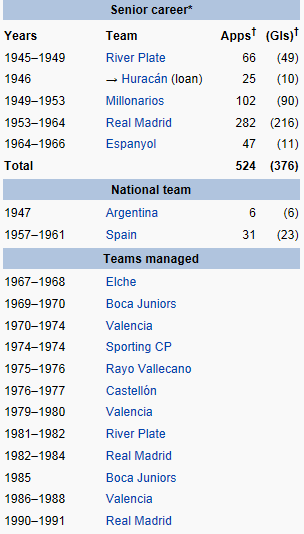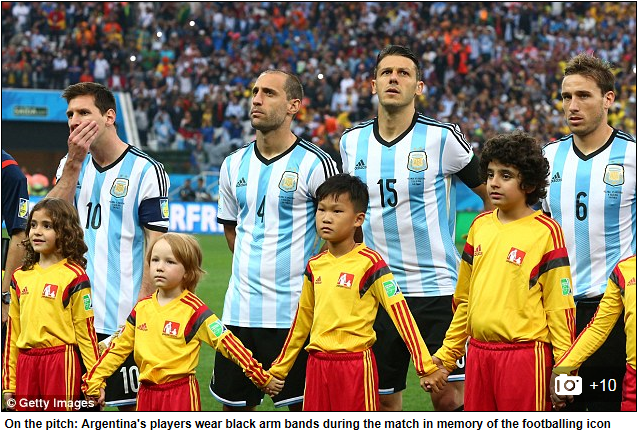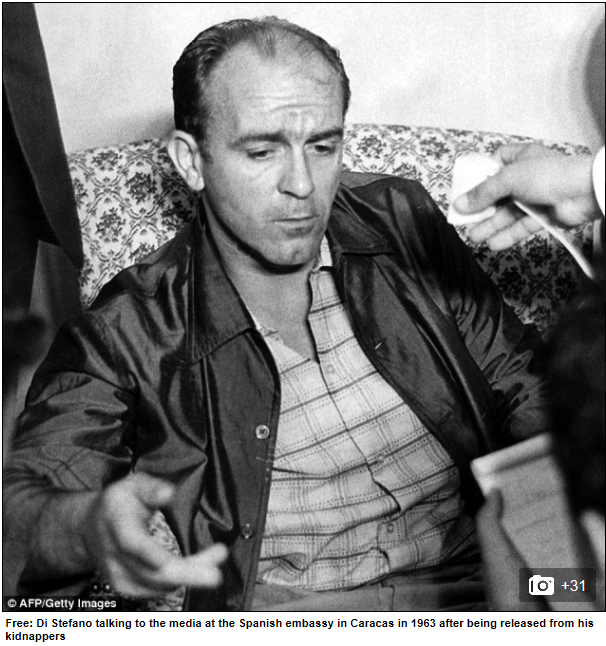Nicknamed “Saeta rubia” (“blond arrow”)
The Argentina-born forward also won eight Spanish league titles and was voted the European player of the year in 1957 and 1959. Di Stéfano scored 49 goals in 58 European Cup ties, a remarkable feat.
An accomplished defender, a midfield workhorse, a playmaker and a prolific striker, he could be seen covering back in defence, charging through the midfield, laying on goals for the forwards and smashing shots into the net all in the same game.
World Cup misses the see the legend:
Di Stéfano played at international level for three countries but never appeared at the World Cup. While he was still eligible to play for Argentina, their football federation withdrew from the 1950 and 1954 World Cups. In 1949, at Millonarios, he played four games for Colombia, though they were not recognised by Fifa. He took Spanish nationality in 1956, but his adopted country failed to qualify for the 1958 World Cup, and after helping them reach the finals in Chile four years later, at the age of 35, he was injured and did not play in the tournament, or again for Spain.

Di Stéfano, nicknamed "Saeta rubia" ("blonde arrow"), was a powerful forward with great stamina, tactical versatility, and vision, who could also play almost anywhere on the
pitch. He is currently the
fifth highest scorer in the history of
Spain's top division, and
Real Madrid's second highest league goalscorer of all time behind Raul, with 216 goals in 282 league matches (was the
league's top scorer in
four seasons straight)
and 307 goals in all competitions. between 1953 and 1964. with 307 goals in all competitions.
Real's apotheosis was the 7-3 victory against Eintracht Frankfurt in the 1960 European Cup final held at Hampden Park, Glasgow. In the autumn of his career he struck up a famous partnership with another great striker of the 1950s, the Hungarian
Ferenc Puskás. Both were then in their mid-30s, Di Stéfano balding and Puskás with a pot belly, but that evening more than 125,000 Scottish fans were held spellbound by their sublime, almost exotic skill in what is still regarded as one of the greatest games ever. Di Stéfano scored three goals and Puskás four.
But
"Don Alfredo" never did share his podium willingly with anybody, as the brilliant
Brazilian inside-forward Didi and the Swedish international centre-forward, Agne Simonsson, found when they joined Real Madrid after the 1958 World Cup, in which both had flourished. Di Stéfano practically refused to pass the ball to them and Didi would later complain that his time at Real Madrid was the worst of his career.
Even Puskás, a dominating figure himself, the captain and star of the dazzling Hungary team of the early 1950s, had to compromise and found his modus vivendi with Di Stéfano when, level on goals with him in the last league match of a Spanish season, he passed to let Di Stéfano score, rather than score himself.
Comments Of Great Footballers on his death:
 Pele
Pele was quoted as saying in Spanish media in late 2009. "For me, Di Stefano is the best. He was much more complete."
 Diego Maradona labeled him as a 'master'.
Diego Maradona labeled him as a 'master'. He praises the late Di Stefano for assisting him in his career. He says as a person Di Stefano was 'phenomenal'.
Charlton praised the footballing brain of Di Stéfano. “I was deeply saddened to hear the news of Alfredo Di Stéfano’s passing,”
England’s record goalscorer said. “As one of the stars of the legendary Real Madrid team, I think
Alfredo was one of the best players I ever came across and an extremely intelligent footballer.
“He was somebody I really respected, having watched him from the stands at the Bernabéu and then played against him. I have many fond memories of my time with Alfredo and feel privileged to be able to call him a good friend. The footballing world has lost a great player and a great man.
The young Bobby Charlton watched Di Stéfano from the stands as a Manchester United reserve at Real's Bernabéu stadium in 1957, and later wrote that his first impression was: "Who is this man? He takes the ball from the goalkeeper, he tells the full-backs what to do; wherever he is on the field he is in position to take the ball, you can see his influence on everything that is happening … I had never seen such a complete footballer … It was as though he had set up his own command centre at the heart of the game. He was as strong as he was subtle. You just could not keep your eyes off him." Di Stéfano was not as naturally gifted as
Pelé or
Diego Maradona, but Charlton is one of many former players and managers who regarded him as the best all-round footballer in the history of the game.
Ferguson described Di Stéfano as one of the greatest players of all time. “The great question that always comes up is who are the greatest players,” the former Manchester United manager told Sky Sports News. “There is a list of great ones like Cruyff, Maradona and Pelé and of course Puskas and Di Stéfano – I thought he was one of the greatest in my mind.
Cristiano Ronaldo ✔ @Cristiano Follow
It’s a very sad day. For me, for all the madridistas, for the world of football.
#EternoAlfredo
Cristiano Ronaldo ✔ @Cristiano Follow
Don Alfredo leaves us, but his memory will last forever in our hearts. Legends never die. Thanks for everything Maestro.
#EternoAlfredo
Luis Suarez ✔ @luis16suarez Follow
Descanse en paz Alfredo Di Stéfano, un genio del fútbol
The Spanish football federation called Di Stéfano an “unforgettable player” in the country’s football history. “He was truly one of a kind on the pitch as well as off it, for his way of understanding life and the wisdom that he generously spread wherever he went,” it said.
Sepp Blatter FIFA President described Di Stéfano as one of the greatest players to grace a pitch. The Fifa’s president tweeted: “Sad to learn of Di Stéfano’s passing, the most complete player I’ve seen. My favourite player. A legend is gone. RIP.”
 Real said in a statement: “The president of Real Madrid, Florentino Pérez, and the club board would like to express its deepest condolences and all their love and affection to their children, their families and friends. Real Madrid extends condolences to those Madridistas around the world and those who feel emotion at the loss of the best player of all time.”
Real said in a statement: “The president of Real Madrid, Florentino Pérez, and the club board would like to express its deepest condolences and all their love and affection to their children, their families and friends. Real Madrid extends condolences to those Madridistas around the world and those who feel emotion at the loss of the best player of all time.”


Selección Española ✔ @SeFutbol Follow
Del Bosque: "I regret the passing away of Di Stéfano a lot"
http://bit.ly/ManagerDiStefano0707 …
David De Gea ✔ @D_DeGea Follow
A sad day for the world of football. One of the greatest has passed away. RIP Don Alfredo di Stéfano
Early History:
Di Stéfano was born in Buenos Aires, the grandson of immigrants from Capri and son of Alfredo Sr, also a footballer who had played for the Buenos Aires club River Plate, and his wife Eulalia, who was of French and Irish origin. He grew up and learned to play football in the streets of the working-class suburb of Barracas and later, after his father had retired from the game, on a farm on the edge of the city.
Curiously he was still in River Plate's third team at the age of 19, as an outside-right, and after quarrelling with the club over money he was loaned to the neighbouring Club Atlético Huracán. But River Plate soon took him back and he became a star, winning the Argentinian championship as top scorer in 1947, and nicknamed the Blond Arrow for his explosive speed. The same year he helped Argentina win the 1947 South American championship, scoring six goals in six matches – his only appearances for his native country.
In 1949, a footballers' strike in Argentina prompted Di Stéfano and many other Argentinian players to defect to a breakaway Colombian league that was outside the remit of Fifa and therefore not obliged to pay transfer fees, but able to pay big wages to some of the world's best players. Along with two other Argentinians, the legendary striker Adolfo Pedernera and defender Néstor Rossi, he joined Millonarios. There he won three league championships in four years and, despite the dubious status of the Colombian set-up, the team was considered one of the best in the world.
"We succeeded in building a team so strong and so homogeneous," Di Stéfano said, "that it was hard to find another like it." But Millonarios's bubble burst in 1953 when Colombia rejoined Fifa and Di Stéfano suddenly found himself without a club, and with heavy losses when he had to sell his property in Bogotá. On Millonarios's final tour of Europe, Di Stéfano ran rings around the Real Madrid defence, and the Spanish club coveted him from that moment.
His move to Spain was one of the most acrimonious and bizarre transfer deals in football history. Real wanted him and agreed a fee with Millonarios, but so did their bitter rivals
Barcelona, who tried to outflank Madrid by agreeing a transfer with his former club River Plate, who still held Di Stéfano's official registration, claiming his move to Colombia had been illegal.
He eventually signed for Barcelona but the Spanish football federation failed to recognise the transfer and, in a Solomonic judgment, decreed that the two clubs share him and he play alternate seasons for each. Crucially, however – and the Catalan club claimed, with Francoist backing – the federation gave Real first bite. When Di Stéfano started his first season slowly, Barcelona were persuaded to sell their rights to the player – a decision they would regret.
Four days later he scored a hat-trick against Barcelona, and that was just the start. In just 30 games that 1953-54 season he scored 27 goals, leading Real to the Spanish championship for the first time in 21 years and sparking an unprecedented era of domestic and European domination. In 11 seasons at Real he won eight Spanish titles (he scored 218 goals in 282 games and was the league's top scorer in four seasons straight); five consecutive European Cups (scoring in all five finals); the inaugural Intercontinental Cup in 1960, played between the European and South American champions; and was named European Footballer of the Year in 1957 and 1959.
DI STEFANO BY NUMBERS
510 official matches played by Di Stefano for five clubs: River Plate and Huracan in Argentina, Millonarios in Colombia and Real Madrid and Espanyol in Spain.
418 goals scored in his club career.
3 countries represented. Di Stefano played for Colombia and Argentina early in his career before later moving to, and playing for, Spain.
22 club trophies won as a player, including eight league titles and five consecutive European Cups with Real Madrid between 1956 and 1960.
5 Di Stefano scored in all five of those European Cup finals with Madrid, including a hat-trick in the last one against Eintracht Frankfurt in Glasgow.
12 teams managed, including Valencia, Real Madrid and fierce Argentinean rivals Boca Juniors and River Plate.
6 trophies won as a manager, including a league and cup double with Boca Juniors. He won five runners-up medals with Real Madrid but managed just one title with Los Blancos - the 1990 Spanish Super Cup
They were about to go into battle for a place in the World Cup final but Argentina and Netherland's players united in tribute to Alfredo Di Stefano, the Real Madrid legend who passed away on Monday.
The remaining semi-finalists observed a minute's silence on the centre circle ahead of kick-off at Corinthians Stadium in Sao Paulo in memory of the Argentinean.
The Argentina players also all wore black arm bands for the match.





















































